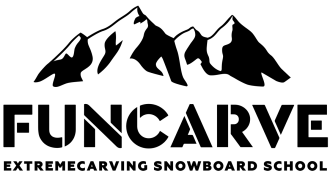Extremecarving. Laid-down turns. Frontside
Laid-down turn is the result of usage of several tricks. Only after learning to combine inclination, rotation and vertical motion you can count on success. Frontside turn is always got learnt a little easier by riders however this is characterized by less fear and the human anatomy. At the same time it is much harder to make the right frontside laid-down turn (this means that loss in speed is minimal) than the right backside one.
Frontside laid-down turn often involves big loss in speed because rider puts intuitively both hands on the slope and transfers too much weight on them. You can learn to place hands on frontside correctly by learning position ‘karateka’ which is described at Extremecarving site as the karate position before the fight.
Phases of laid-down turns
Phase of rise initiation is added to the usual phases of a carved turn. This phase includes actions of the rider aimed to gentle take off from the slope and to getting the basic position. Unfortunately most of the riders weren’t able to change their perception of carving and they believe mistakenly that it is necessary to rise from the laid-down turn using hands to push them from the slope.
In fact the main role is played by the position of the most massive part of our body – torso. You should learn to use the muscles of your abdominals and back to shift the centre mass slightly higher than the support and then inertia of its motion will lift you up itself.
Frontside laid-down turn
In the very beginning of the turn when after edge changing the board still moves along the perpendicular of the slope you should make a deep inclination having your knees bent and keeping your back straight and to put your forearm on the slope. Then in the process of the turn you should straighten smoothly your legs, press your body to the snow and put your arm above your head taking the karateka position.
After crossing the fall line you need to initiate the take off from the slope by using the force of your back muscles with your back arched and trying simultaneously to keep your shoulders in ‘minus’ position. You need necessarily support for the rise and there is no sense in bending knees before you took off from the slope because bending of the knees means unweighting of the board. You cannot unweight something that wasn’t weighted. And after the take off you need to finish the turn* up to perpendicular in ‘minus’ position and to change the edge with your knees bent.
Typical mistakes
- You should strictly avoid tilting your body forward to achieve more effective inclination and more soft and smooth laid-down turn.
- Support yourself with hands on the slope too much. When you do so the effectiveness of inclination decreases, you break 50:50 weight distribution and you lose the speed because of strong friction.
- You put your forearm late. When you do so you incline later than you should and your inclination becomes maximum only by the phase of speed loss and also in this case you straighten your body not along the slope but up from it.
- Harsh knees unbending leads to board unweighting, carve breakage and you lose your 50:50 weight distribution.
- Attempt to stretch out your back arm in front of you. This intuitive and protective movement makes you turn your shoulder into ‘Plus’ position, make too big angulation and lose your 50:50 weight distribution.
- Shift your back arm behind your head and keep your leading arm in front of you just in case.
- Slow knees bending in the phase of rise leads to the loss of lifting force.
- Attempts to push yourself from the slope with your arms. In this case rider’s weight removes from the snowboard, they lose the speed and the lifting force. Besides their hips stick out and rise becomes faltering, unstable and uncertain.




